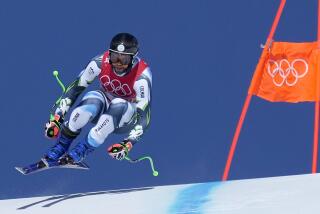Downhill dreams? Get fit first
- Share via
If you’re like me, you’ve recently started daydreaming about the first ski run of the year: The sun, the powder and the graceful mountain beauty. But what about the gasping, the quivering muscles and the crippling soreness of the Day After? It’s time to start thinking about that too.
Skiing and snowboarding require baseline fitness and training of muscles we don’t typically employ. This is especially true for those of us who were downhill hellcats in our reckless youth but now ski just a few days a year and spend much of our time hunched in front of computer screens, muttering. Clicking directly into ski boots and heading down the hill with no preparation is a recipe for an orthopedist’s favorite entree.
The following is a regimen to help you boost performance, reduce next-day stiffness and help keep you off the ski patrol’s emergency sled.
Four to six weeks before your first trip, focus on cardiovascular fitness. “You want to raise your anaerobic threshold -- the point at which your muscles start to burn,” said Andrew Hooge, a strength and conditioning coach in Colorado who has worked with numerous competitive and recreational skiers.
This means interval training: Warm up for five minutes (cycling or running), then sprint for 30 seconds at 90% of maximum exertion, recover for 30 seconds; repeat the sprint-recover sequence five times. Increase each sprinting interval by 15 seconds each week. (If you’re not up for that, apply the same go-hard-and-rest principle at whatever intensity and time periods you can safely handle.) Doing intervals will boost your body’s efficiency in shuttling oxygen to your muscles, increase your endurance and reduce fatigue late in the day (when most injuries occur).
For core strength, Hooge recommends dumbbell dead lifts -- squatting to pick up dumbbells and holding them with arms straight down as you rise. (All his exercises are detailed in his book “Fitskiing: Your Guide for Peak Skiing Fitness”; a few are explained on his website, www.fitskiing.com.) “These are great for skiing: a whole-body workout that mimics the up-down movement,” Hooge says. Dead lifts strengthen your core, quadriceps, glutes (your butt), hamstrings (the long muscles running down the back of your legs) and lower back.
For balance and explosive power -- and preparing to take on moguls -- numerous experts recommend lateral hops or forward jumps. Put a rope on the floor and jump back and forth across it, for 30 seconds at a time, with feet close together. Do two to three sets, and increase the time as you get more fit. Snowboarders should practice balancing on their heels and the balls of their feet, using a wobble board or skateboard.
If you’re prone to soreness in your shoulders and upper back, add some front raises: Hold a dumbbell in each hand and extend each arm, one at a time, in front of you until your hand is even with your shoulder. Hold for three to five seconds, then lower it. “We hold our ski poles out there all day,” Hooge says. “This exercise strengthens the back and shoulders and abs -- it helps stabilize the whole body.”
To prepare for bodily twists (voluntary or otherwise), Hooge prescribes torso rotation exercises -- using the cable cross machine at your gym, for example, or exercise bands at home. The U.S. Ski Team version calls for turning your torso while doing sit-ups and holding a weight or medicine ball. “This also helps prevent herniated discs,” Hooge said. “The most common way to herniate a disc is bending and rotating.”
Hooge’s workout should take 45 minutes three days a week. If you lack that time, he said, “Any [training] you do prior to hitting the slopes will improve the connection between your brain and muscles, which helps your muscles fire and stabilize your body when you need it.”


